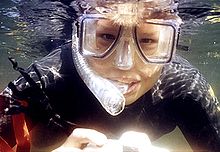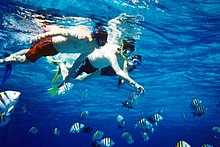Snorkeling is the use of a breathing tube to swim on the surface of the water. The equipment required for snorkelers includes diving goggles, fins, snorkels and swimwear.
Snorkeling is a popular leisure activity especially in tropical resorts and scuba diving areas. Its most important attraction is that it can observe underwater creatures in the natural environment without the need for complicated equipment and training such as scuba diving, and it will not be disturbed by blisters during observation.
Scuba divers also use snorkeling on the water. Rescue and search teams also use snorkeling while searching on the water. Snorkeling is also used in sports such as underwater hockey.
Breathing tube
The snorkeling snorkel is generally 30 cm long and its inner diameter is about 1.5 to 2.5 cm wide. They are generally L or J-shaped and generally have a mouth at the bottom. They are generally usedrubberorplasticMade. Through it, the mouth and nose of the snorkeler can sink in the water, but continue to breathe. The snorkel generally has a piece of rubber that connects the snorkel to the strap of the diving goggles. Old-fashioned snorkels are also directly sandwiched between the strap and the head, but this often causes the diving goggles to leak.
The most common breathing tube is a simple tube, which can be completely submerged under water. There are two ways to drain water when snorkeling: he can blow hard after coming out of the water, or he can exhaust when he is about to reach the water surface, until he comes out of the water, then straighten his head and inhale again. The latter is to squeeze the water out of the pipe through exhaust. This method is more effective, but it requires some training.

Some modern breathing tubes have a water socket on the mouth, so that a small amount of water can stay in the breathing tube without affecting breathing. Some have a one-way on the sinkvalve, It can automatically drain after filling water in the sump. Some snorkels have a valve on the top to prevent water from entering the snorkel when snorkeling underwater. Some more advanced snorkels can even prevent water from splashing into it, so that water does not enter the snorkeler’s mouth.
Some snorkels have a cage with a small ball at the opening to prevent water from splashing in, but such snorkels are no longer produced and are not recommended because they may be dangerous to snorkelers. Similarly, diving goggles equipped with snorkels are considered unsafe and are discarded.
The optimal length of the breathing tube should not exceed 40 cm. A longer snorkel does not make the snorkeler dive deeper, because if he wants to dive deep, his lungs will sink into deeper water and he will be exposed to greater water pressure. under these circumstancesmuscleNot strong enough to make the lungs of the snorkeler expand when inhaling. If the breathing tube is too long, every time the snorkeler inhales part of the breath he exhaled last time, it will reduce the efficiency of breathing and lead toHypercapnia. The larger the volume of the breathing tube, the more serious this problem is. Leave the opening
The development of breathing tube technology has enabled this problem to be solved now. For example, an advanced breathing tube uses a one-way valve to separate the inhalation and exhalation pipelines. In addition, the underwater inhalation pipeline is sealed so that the snorkeler does not have to exhale first after ascending.
Diving goggles
Snorkelers generally wear diving goggles similar to those used by scuba diving people. It forms a place with air in front of the snorkeler's eyes, so that the snorkeler can watch underwater more clearly. All scuba diving goggles also expose the nose to the air. They also include straps to wear diving goggles on the head. The straps have various shapes and their materials are also different. The most common ones are rubber or silicone resin.
practice

Although wearing goggles and snorkels in any waters can be called snorkeling, snorkeling is generallyreef、ShipwreckOr near other underwater objects. The purpose of snorkeling is to observe aquatic life such asfish、SeaweedOr watch the rocks underwater. Snorkeling is generally regarded as a kind of leisure, notphysical education。
Snorkeling does not require special training, only the skills to be able to swim and breathe through the snorkel. For safety reasons, it is generally recommended that "experienced" snorkelers, tour guides, diving shops or diving equipment rental shops provide guidance. The guidance content includes equipment use methods, basic safety measures, precautions and species protection guidance. As with scuba diving, it is generally recommended not to snorkel alone, but to snorkel with other people or under the guidance of a guide.
Some commercial snorkeling areas require snorkelers to wear similarlife jacketThe inflatable vest. These life jackets are generally brightyelloworOrange, And wear facilities that allow users to inflate or exhaust them to adjust their buoyancy. But these vests prevent snorkelers from diving to the depth they want. Snorkelers in cold water should wear correspondingly thick wetsuits. Snorkelers in the tropics often wear clothes and shorts to prevent sunburn.
Experienced snorkelers often startFree divingThey should at least get some guidance from experienced freedivers before doing so.
Safety attention
The biggest danger for snorkelers is small yachts and speedboats. Snorkelers are often completely buried under water, with only their breathing tubes exposed on the surface. Since these ships are cruising where snorkelers are snorkeling, there is a possibility of collisions. Sailing boats and surfers are also very dangerous because their drive system is very quiet so snorkelers may not know that they are nearby. In contrast, the sound of motor boats can travel far underwater. Snorkeling may be hit by these ships. There are only a few places to separate snorkelers from these boats, so snorkelers should wear brightly colored and reflective clothes, and they should be marked so that the boat and others can easily see them.
The snorkeler's back may be exposed to the sun for a long time and get sunburned, but he didn't notice it. Wear appropriate clothes to protect yourself from sunburn.
Dehydration is another danger. Therefore, it is recommended to snorkel and drink plenty of water, especially if he intends to snorkel for a long time. Drinking water can also prevent cramps.
Snorkelers may happenHyperventilation syndrome, Resulting in shallow water shock. Snorkeling with a companion can help avoid this situation.
existCoral reefWhen snorkeling nearby, you need to be careful not to touch the coral and the poisonous creatures living in it. Snorkelers should wear gloves and be careful here. Shoes and fins are especially useful on shallow reefs, and snorkelers can wear them to the depths of the water.
From the perspective of ecological protection, contact with corals should also be avoided to prevent them from being destroyed.
Place


Snorkeling is possible in almost all waters, but most snorkeling is done in places where the waves are small, the water is warm, and there is something particularly interesting not far below the surface.
The reefs from one to four meters deep on the surface are most popular with snorkelers. Deeper reefs are also good, but such reefs require snorkelers to hold their breath frequently, and the physical requirements for snorkelers are relatively high.
